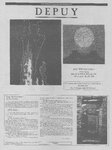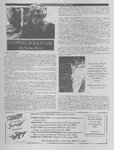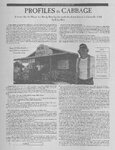| OCR Text |
Show THE ZEPHYR/ AUGUST-SEPTEMBER 2004 : : TAMARISK? DEFENDING As Abbey used to say: ‘Somebody has to do it." My futile efforts to stop a futile program at Arches National Park By Jim Stiles AUTHOR’S NOTE: At the outset this story is incomplete. While most of what follows is an account of a tamarisk control project in the late 1980s, I had hoped to update Arches National Park's tamarisk control program, including detailed current information about success rates and the cost of the NPS efforts to eradicate exotic plants. About two months ago, I filed a Freedom of Information Act request (FOIA) with Arches NP to obtain that information and was supposed to receive the material in 30 days. But four days past the deadline, I received a letter from Southeast Group Superintendent Tony Schetzsle, explaining, “We are unable to meet that date due to previously planned activities requiring our staff to be devoted to prior projects,” and advised me that he was “applying an additional 45 days to provide the information you requested.” If the activities were “previously planned,” it seems the park could have notified me earlier, before I committed this issue to the theme of exotic plant eradication, but the deed is done (or not done) and we'll have to live with it. When the FOIA request is fulfilled, I will share the information it contains in a future issue...JS The only non-human living entity I have ever tried to hit and inflict physical pain upon is a tamarisk tree. Not only is it an invasive, water-sucking exotic plant that has no business strangling every watercourse in the American West, the hot, suffocating jungle-like mass of tangled branches creates a hiking nightmare. I once became so trapped in a stand of tammies along Salt Wash that I began lashing out at the resilient little tamarisk tentacles with my walking stick...[ wanted to hurt them. Tamarisk has choked canyons and washes across the Southwest, it has altered the banks of the Colorado River, it drinks millions of gallons of water and allegedly diminishes wildlife diversity. It is the scourge if many...so why am I defending it? Because as Abbey often said, “Somebody has to do it.” Or maybe it’s simply, “Don’t start fighting your enemies until you know how to defeat them.” Tamarisk is so pervasive in parts of Arches National Park that many of us have come to acceptits p , albeit reluctantly. Trying to eliminate a small thicket of tamarisk is liking placing a band-aid on an avulsed wound. It’s hopeless. The dense stands of tamarisk at Wolfe Ranch altered its appearance so drastically that when John Wesley Wolfe’s daughter returned to the ranch in the late 1960s, she barely recognized the place. The persistent exotic grows along the Colorado River from the Gulf of California to the river’s upper reaches. At Arches it has crept up every side canyon along the way. Tamarisk dominates Salt Wash and Courthouse Wash, the park’s two major perennial streams. Tamarisk has been found growing along the park road, where it gets an extra shot of water when rain water runs off the asphalt. I’ve found it growing in potholes, a dozen miles from the nearest stream. Trying to just cut it is a hopeless and futile task. The roots run deep and the plant will grow back, fuller and denser than ever. Fire has no effect. As a result the NPS has resorted to poisoning tamarisk. Early in the project, the NPS used a chemical called 2-4-D, a toxin so deadly that its use was stopped and replaced with another chemical called Garlon. It has been used effectively for 15 years. Effective to a point. Despite heavy treatments, some of the tamarisk always comes back and annual or semi-annual applications of the poison are absolutely necessary. In addition, tamarisk spreads itself so easily. A mature tamarisk plant conservatively produces 100,000 seeds that can be carried by the wind and deposited miles away. When it lands in a wet location, germination is a certainty. And so, when the NPS dedicates its time, money and resources to the elimination of tamarisk, even in a confined location, it is making of wildlife that was unmatched anywhere else in the park. In the spring and early summer, fledgling Great Horned Owls resided in the branches of the cottonwoods and even in the tamarisk. A Cooper’s Hawk nest was occupied every spring for a decade. Deer and coyotes regularly visited the spring. I saw or noted the sign of kit fox and ringtail cats. It was, in effect, a meeting place for Life in an otherwise very inhospitable location. As the summer wore on, the flowing water stopped and the pool shrank, but it never disappeared. Even in September, standing water, shaded by the tammies, had survived the intense desert heat. I wondered if I should tell anyone about this magical spot. I hesitated for two reasons—first, even then, I’d knew that identifying “secret places” could have a devastating effect. Too many well-intentioned admirers can spoil just about anything: Second, I realized that “beauty is often in the eye of the beholder.” A dedicated tamarisk hater would only THE SECRET SPRING (Above) The cottonwoods and tamarisk along Salt Valley Wash. 1986. (Below) The pool. October 1979. that commitment forever...for Eternity. Until the End of Time. Even weed warrior Bill Wolverton (featured in the story that precedes this one) acknowledges that his efforts along the Escalante River will have been an exercise in futility if his exotic plant elimination work isn’t maintained in the future. There is no alternative. But even if the NPS dedicates itself to tamarisk eradication for the next hundred Millennia, is it a good idea? I began to have my doubts when I discovered the “Secret Spring.” A BRIEF HISTORY... One day, almost 25 years ago, I was shirking my duties as a seasonal ranger and hiding as best I could from the tourists who had invaded the park for Memorial Day Weekend. I had sought refuge on the old 4WD road that follows the spine of a ridge near the western edge of Salt Valley. From my vantage point on the rim, I could look across the valley to the Devils Garden and Fiery Furnace. I could see the park road and the bustle of activity-the moving glint and glare of reflected Winnebago motorhomes and Airstream trailers and yupstermobiles. Unable to endure that scene any more, I let my eyes fall to the valley itself, into the grey mancos badlands that dominate the south end of the confusing geology created by a collapsed salt dome, millions of years ago. Within that moonscape, something caught my eye--it was an unnatural flash of green. I reached for my binoculars for a closer look and even from this distance, could make out several large cottonwood trees and what appeared to be a thicket of old tammies. I made anote of this anomaly and planned a visit there on my next scheduled backcountry day. The following week, I took my first exploratory hike to a place I’d never heard mentioned by the other rangers. What I found was an odd oasis in the desert. The sight of a spring fed patch of green is startling because it’s so unexpected. The hike to the spring winds through elephant backs of Mancos shale and there is no clue of the teeming life to be found until that last turn of the wash. I emerged from the badlands near the oasis’s southern end and began walking upstream beneath a canopy of tamarisk. Unlike the thickets I was accustomed to along the Colorado, many of these were trees—some of them a foot thick—-and there was little evidence of new growth. The floor of the wash began to appear damp and eventually a trickle of water appeared over the sand. Near the north end of the oasis, several mature cottonwoods grew by the wash. Just beyond them, I discovered a pool of water, hidden in the shade of some tammies-beyond this point, the desert reclaimed the land. The pool was insignificant by most standards; it was no more than a foot deep and three feet wide and perhaps eight feet long. But for the next ten years, that pool was always there and it provided water to a variety of animals. From here, it was at least three miles to the nearest permanent water. What I discovered at the spring in the weeks and months and years ahead wasa PAGEI4 diversity , lodeed a prescribed bere had been scheduled for March 27, 1987. The fire was postponed until autumn when the NPS could not locate a fire boss to supervise the burn. want to tear it down. In this case, I thought tammie eradication could do more harm than good. So I proclaimed my discovery the “Secret Spring” and decided to keep it mostly to myself. In ten years I revealed the Secret Spring to my fellow ranger Mike Salamacha, a dedicated tamarisk foe and to the Chief Ranger, also no fan of exotic plants. Both of them agreed-—the best way to protect this area was by leaving it alone and for a decade, it stayed that way. 1987...TO BURN OR NOT TO BURN In 1987 everything changed. Arches National Park found itself with a new superintendent, a vacant chief ranger position and, for the most part, a new seasonal staff. I’d left the NPS in the fall of 1986. Salamacha transferred to another park. But the acting chief ranger, a strong proponent of tamarisk removal, had discovered the “Secret Spring” on his own in 1985 and moved forward with a plan to remove the tamarisk. It was only by accident that I became aware of the project. In March 1987, as a civilian now, I made a sentimental hike to the spring, just to visit and to say hello. I was surprised to find a large cache of fire tools near the spring; clearly a controlled burn was in the works. I inquired about the equipment and discovered that indeed a prescribed fire had been planned for March 27, 1987. The fire was postponed until autumn when the NPS could not locate a qualified fire boss to supervise the burn. The plan called for the burning of the tamarisk in place; that is, the NPS intended to torch the tamarisk where it grew, despite the fact that many of the exotic plants grew near and even under the very cottonwood trees the NPS maintained it was trying to save. Such an approach would have been devastating. In addition, the park proposed to go forward without writing an environmental assessment. It was to be the largest controlled burn in the |


































